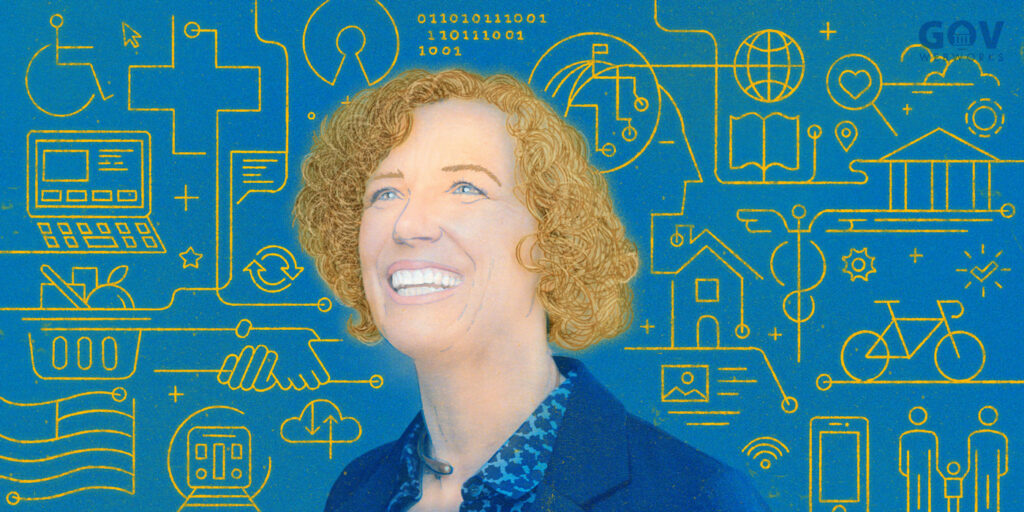Our Insider Insights interviews bring together insights from authors, consultants, coaches, and other industry experts on topics relating to online digital innovation.
Find highlights, and links to the full interviews, below. Topics include civic tech with Cyd Harrell, conversation design with Jon Bloom, information architecture with Abbey Covert, and modernizing online benefits with Jamie Brennan.
See Industry Experts: Volume I for further insights on public interest technology from Tara McGuinness and Hana Schank, Michael Sahota on evolutionary agile leadership, Katie Swindler on user-centered design, and content strategy with Padma Gillen.

Cyd Harrell: Author and San Francisco chief digital services officer
The benefits of user research and civic tech
Civic tech is defined as technology that “assists government in delivering citizen services and strengthening ties with the public,” says GovTech. In A Civic Technologist’s Practice Guide, Cyd Harrell invites readers to join the growing civic tech movement with “the aim of making government more responsive, more efficient, more modern.”
Now San Francisco’s chief digital services officer, Cyd has previously worked in civic tech at the nonprofit organization, Code for America, as chief of staff at 18F, the federal technology and design consultancy, and most recently as a usability consultant for the California Courts self help guide.
Read the full interview…
Why is usability so important in civic tech?
“At its core, usability is about respecting people’s time and agency. If an interface is hard to use, or imposes time burdens on people, it breaks trust and damages the relationship between that user and the organization responsible.
In private life, a user might address this by turning to a competitor or choosing not to engage, but those options aren’t available with government.
If it’s too hard to register to vote in my county, I don’t have the option of registering somewhere else. If I need income support during a global pandemic, only the government can provide that service. So rather than a competitive advantage, usability in the public sector becomes a moral responsibility.”
Jon Bloom: Google conversation designer
Communicating with digital interfaces

“When you or I have conversations with people, the interactions don’t just consist of words. We shrug, point, roll our eyes,” says Jon Bloom, a conversation designer at Google. “Conversations with digital assistants should be just as dynamic.”
Bloom’s work at Google is about making conversations with digital assistants as much like talking to humans as possible.
Read the full interview…
What do conversation designers know about conversation that the average person does not?
“Fair question! The challenge is that because we are all so good at carrying on conversations, the subtleties become invisible to us. To use a single example of this invisibility: The average pause between conversational turns is about 200 milliseconds. Even subtle variations in the length of that pause can be meaningful. A longer pause could communicate distaste in what was just heard or a lack of certainty in the upcoming response. A response that is quicker than 200 milliseconds could imply great certainty, but could also be considered rude in some cultures.
As conversation designers, our job is to sweat these details. I can ride a bike, but don’t ask me how I do it! It’s the conversation designer’s job to understand how.”
Abby Covert: Author and information architect
Turning information messes into clear messages

Abby Covert, author of How to Make Sense of Any Mess and a leading information architect (IA) consultant and teacher, is on a mission to demystify the practice of information architecture. Her credentials include teaching IA at SVA’s Products of Design program, the Design Operations Summit, and the Advancing Research Conference. She also founded World IA Day, an annual event that brings IA education to local communities. She provides insight into the benefits of architecting user centered information in work and life.
Read the full interview…
What do you say when people question the value of IA?
“Information architecture always exists. It’s not something you get to choose to use or not, because everything has a structure and language that people use to make sense of something. However, the weaknesses at the structural and language level can get in the way of the message you intend to convey and no amount of redesigns or re-platforms can fix what’s wrong.
If you don’t pay attention to the quality of those structures and your use of language, there’s a higher likelihood people won’t make sense of your message. So it’s a risk to not place value on thinking about your IA up front.
Jamie Brennan: Project manager and consultant
Streamlining integrated eligibility system modernization
 “Integrated eligibility systems (IES) are the gateway to state benefits for citizens,” says Jamie Brennan. “From an information technology perspective, there’s no more important place to support people in need.” Over the past decade, one of Jamie’s main goals has been to modernize state IES and enrollment solutions, and support the integration of health and social services programs and Medicaid.
“Integrated eligibility systems (IES) are the gateway to state benefits for citizens,” says Jamie Brennan. “From an information technology perspective, there’s no more important place to support people in need.” Over the past decade, one of Jamie’s main goals has been to modernize state IES and enrollment solutions, and support the integration of health and social services programs and Medicaid.
Read the full interview…
What can states gain from IES modernization?
“Modernization, when done right, offers an opportunity to refocus and improve user experience in these systems, whether for citizens accessing services via cell phone, or for state staff navigating complex workflows in the admin portal.
If you can consolidate four or five systems down to one or two, you’re saving a lot of time on patching, deployments, and upgrades for duplicate technology architecture. And on cost for maintenance and operations.”
Learn more
- Public Sector Insider Insights Tips: Download tips from top minds on how to succeed in gov tech
- Industry Experts Series: Volume I with Tara McGuinness and Hana Schank on public interest technology, Michael Sahota on evolutionary agile leadership, Katie Swindler on user-centered design, and Padma Gillen on content strategy.
- Industry Experts Series: Volume III with Cyd Harrell on civic tech, Jon Bloom on conversation design, Abbey Covert on information architecture, and Jamie Brennan on modernizing online benefits tools.
- Contact us to learn more about how digital tools help government adapt
Join our team
We’d love to hear from you. We have a variety of remote and hybrid positions available.
- Check out our current job openings
- Contact us with any questions
- See PWW/GWW clients: Portfolio of work
- Visit us on social media: LinkedIn, Facebook, Twitter
